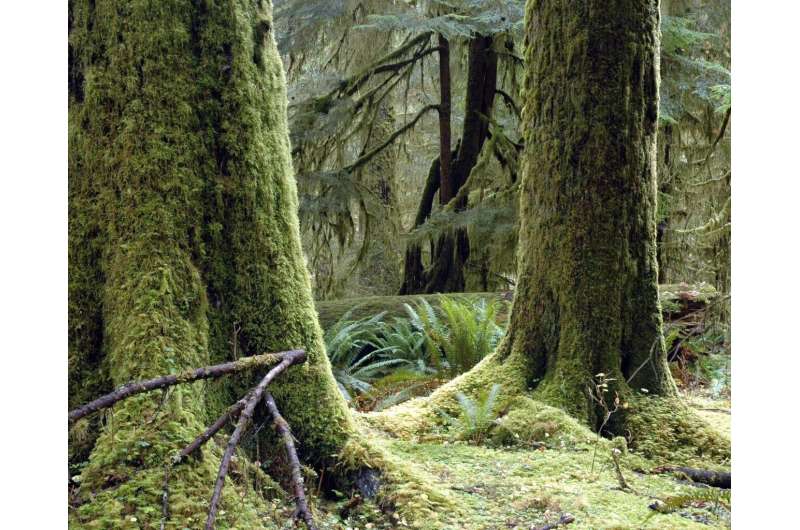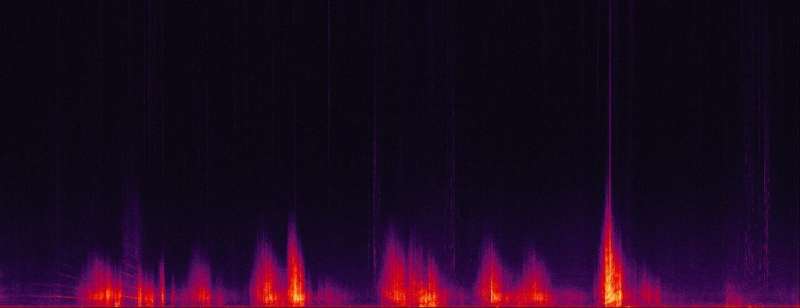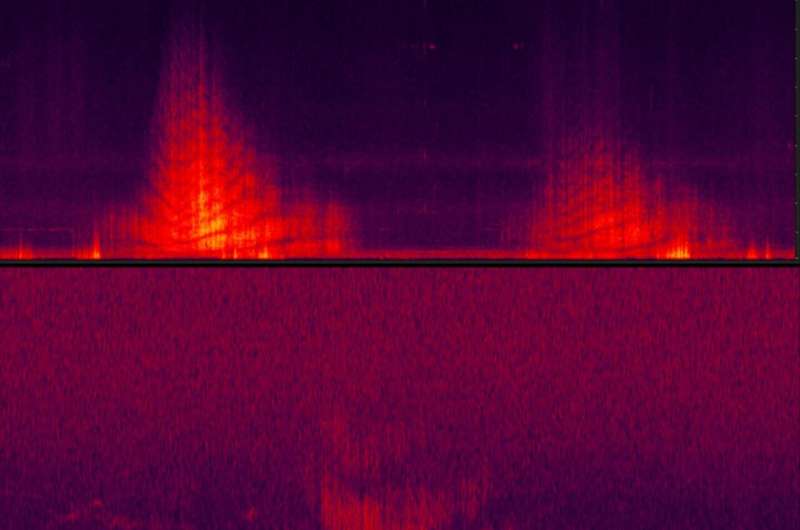The Hoh Rain Forest in Olympic National Park. An area within this forest in Washington state for years held the distinction as one of the quietest places in the world. Credit: Quiet Parks International
An area in the Olympic Peninsula's Hoh Rain Forest in Washington state for years held the distinction as one of the quietest places in the world. Deep within the diverse, lush, rainy landscape the sounds of human disturbance were noticeably absent.
But in recent years, the U.S. Navy switched to a more powerful aircraft and increased training flights from its nearby base on Whidbey Island, contributing to more noise pollution on the peninsula—and notably over what used to be the quietest place in the continental U.S. While local residents and visitors have noticed more aircraft noise, no comprehensive analysis has been done to measure the amount of noise disturbance, or the impact it has on people and wildlife.
Now, as the Navy is set to implement another increase in flight activities, a University of Washington study provides the first look at how much noise pollution is impacting the Olympic Peninsula. The paper found that aircraft were audible across a large swath of the peninsula at least 20% of weekday hours, or for about one hour during a six-hour period. About 88% of all audible aircraft in the pre-pandemic study were military planes.
"I think there is a huge gap between what the Navy is telling people—that its aircraft are not substantially louder and operations haven't changed—and what people are noticing on the ground," said lead author Lauren Kuehne, who completed the work as a research scientist at the UW School of Aquatic and Fishery Sciences and is now an independent consultant. "Our project was designed to try and measure noise in the ways that reflect what people are actually experiencing."
The study was published Nov. 25 in the journal Northwest Science.
The Navy is set to implement a 75% increase in air activities over the Olympic Peninsula, a place that is historically, culturally and ecologically significant. Eight American Indian tribes call the peninsula home, while Olympic National Park receives more than 3 million visitors a year and is a UNESCO World Heritage Site. More than two dozen animal species are found only on the peninsula, and multiple species are listed as threatened or endangered under the federal Endangered Species Act.
This spectrogram (a visualization of sound level at different frequencies) shows an hour of audio collected at one of the study sites, Third Beach, on Oct. 3, 2017. Each peak is a military Growler aircraft flight, with brighter colors indicating louder noise levels. Credit: Lauren Kuehne
"The Olympic Peninsula is a renowned hotspot for wildlife, home for people of many different cultures and a playground for outdoor enthusiasts," said co-author Julian Olden, professor at the UW School of Aquatic and Fishery Sciences.
The researchers chose three primary sites on the Olympic Peninsula to monitor the soundscape during four seasonal periods from June 2017 to May 2018. Two sites, at Third Beach and Hoh Watershed, were near the coast, while the third site was inland on the Hoh River Trail. They placed recorders at each site to capture sound continuously for 10 days at time, then recruited and trained volunteers to help process the nearly 3,000 hours of recorded audio.
"This data is very accessible—you can hear and see it, and it's not rocket science," Kuehne said. "I wanted people to feel like they could really own the process of analyzing it."
From their analysis, the researchers identified nearly 5,800 flight events across all monitoring locations and periods. Of these, 88% were military aircraft, 6% were propeller planes, 5% were commercial airplanes and less than 1% were helicopters. Three-quarters of all recorded military aircraft noise occurred between 9 a.m. and 5 p.m. on weekdays. Most of the military aircraft were Growlers, or Boeing EA-18G jets that are used for electronic warfare—drills that resemble "hide and seek" with a target.
The researchers found that most of the aircraft noise was intermittent, detectible across all the sites that were monitored simultaneously, and followed no set pattern. The noise mostly registered between 45 and 60 decibels, which is comparable to the air traffic sounds in Seattle, Kuehne said. Occasionally, the sound level would hit 80 decibels or more, which is akin to the persistent noise when walking under Seattle's former waterfront viaduct.
Conversations with local residents also revealed a majority who notice the low-level jet noise, the researchers said. The chronic and unpredictable nature of the noise is especially tiresome for residents, and some report difficulty sleeping, learning in school and even interference with hearing aids.
Contrasting spectrograms of military Growler aircraft (top) and commercial aircraft (bottom) events showing the frequency and strength of audio signals for a period of time. Credit: Lauren Kuehne
Previous research has shown that loudness is only one aspect of how sound can impact human health. Studies have found that the duration of noise, unpredictable patterns and the inability to control exposure all contribute to stress, annoyance, sleep disturbance and interference with learning.
Noise impacts on wildlife are less studied, but some research has shown it can prompt physiological stress and impact animals' ability to reproduce successfully. Noise can also interfere with how animals communicate and find prey.
"The deafening sound of anthropogenic noise not only threatens wildlife but may also deter people from visiting in the future," Olden said. "Why travel to the Olympic Peninsula to only experience noise comparable to Seattle?"
The researchers hope these results will prompt follow-up assessments of how chronic aircraft noise impacts residents on the peninsula. They also hope the Navy will publicly acknowledge the extent of its noise pollution and consider changing its operations near the peninsula.
"My wildest-dream scenario is that this would allow the Navy to take seriously people's requests that they move at least some of the training elsewhere, to other military operations areas," Kuehne said.
More information: Lauren M. Kuehne et al, Military Flights Threaten the Wilderness Soundscapes of the Olympic Peninsula, Washington, Northwest Science (2020). DOI: 10.3955/046.094.0208
Provided by University of Washington


























